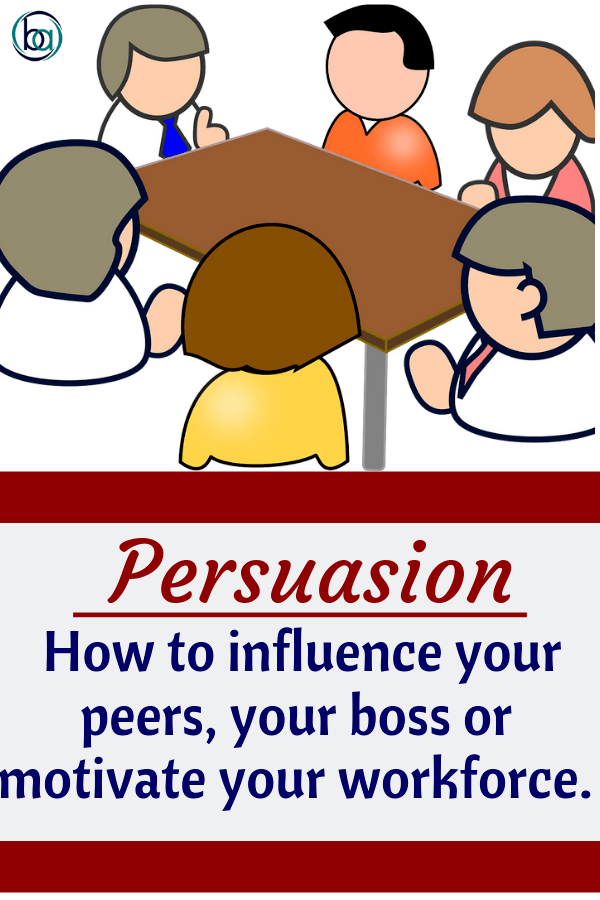8 Keys To Master The Art Of Persuasion
Can you get your peers to see things from your point of view? Do you have great ideas but you are unable to convince your coworkers or your boss, or are you a business owner finding it difficult to get your staff to adjust to new changes? Maybe you need to master the art of persuasion.
The art of persuasion is a skill that is important to have in today's world. At various times in your job, you need to persuade employees, clients, co-workers, or your boss about your plan.
Why You Need It As A Professional
At some point, you will need to either pitch your idea, negotiate some contract or decline some tasks. Your success at any or all of these situations will largely depend on your ability to influence someone or some group so that they see things from your perspective, and consequently accept your proposal. Failure to hone this skill will leave you feeling frustrated, defeated or disappointed more often than necessary.
Why You Need It As A Business Owner
In today's workforce, employee engagement is one of the keys Gallup has found to influence employee performance and consequently organizational success. If you are a business owner or chief executive, you want workers who have a sense of ownership and are committed to the goal and vision of your business.
You can't achieve employee engagement and commitment by giving orders. You can only accomplish this by persuasion. Nothing can achieve this better than when you motivate your workforce to embrace your vision and goal for the organization. Hence, the need to learn the art of persuasion.

What It Is Not
The art of persuasion is not used to manipulate or deceive but should be used to present your point of view in a way that all parties involved understand what you mean. You want them to see things from your point of view but not in a domineering or deceitful way. You also should be open to listening to others and ready to compromise where it makes sense.
8 Keys To Master The Art Of Persuasion
You may tell me that your focus is on the content of your message. However, you fail to realize that the way you deliver your message to your recipient affects the content of your message. You will not get the expected result if your what you say is misinterpreted, hence the need to master the art of persuasion.
It is not only necessary for employees to know how to persuade their bosses but also crucial for executives to influence their workforce too.
For most people, the art of persuasion is not a natural talent. The ability to capture your audience, to get them to understand your point of view and then to sway them to change their position as needed is a gift that comes naturally to only a few people. Therefore don't be dismayed if you lack this skill. You can, however, learn from strategies that work.
It is important to understand that people's experience, exposure, culture, and knowledge influence their style of communication. It is safe to state that what may be a great way of communicating with one person may have the opposite result with another person. Therefore active listening and observation is a vital component of persuasion.
1. Establish A Relationship
Establishing a relationship with colleagues and clients is about building connections with the people you work with, and this is necessary if you want to master the art of persuasion. It is easier to convince people you know that is why people often say "better the devil you know than the devil you don't."
You do not know where people stand neither would you understand their nuances if you don't connect with them. The connections you make in relationships will not only help you when expressing your ideas and counter-arguments, but it will also help you meet some or all of the demands of your audience while putting together your ideas. If you know what people want, you can incorporate it into your proposal so that you have a win-win proposition.
Even if you are going to present to a room full of people you don't know, you can still establish a relationship with them by getting to the venue early and meeting with as many people as you can. Seek their perspective on the idea you have to present. Ask for their background and find out what their reservations are.
You want to form genuine relationships, don't fake it. Your co-workers may not be your best friend but remember you spend the majority of your time with them. Having a good working relationship makes the job easier!

2. Learn Their Background Information
Learning about the background information of your client, co-workers, employees, or boss helps you to get a better understanding of how they think and communicate. For example, if you know that your boss had a bad experience with an idea similar to yours, you would make sure to differentiate how your idea would succeed while the previous one failed. You would go the extra mile in your preparation to include facts and evidence on how your idea is different and better than the one your boss experienced before.
If you are unaware of your boss's previous experience, you may not be prepared to include information that would convince your boss that your idea is different and better. Your boss will reject your idea.
Finding out background information is not about digging into another person's private life. What you want to find out is how any previous experience, exposure, and education would impact how that person receives your information. Armed with this knowledge, you would aim to ensure they would have a positive experience and you would present your ideas in a way that you alleviate the fear of them thinking they would have the same negative experience.
The same works if the experience they have is positive, you could build on previous positive experiences to help them connect with your current proposition.
- Finding out background information works in an interview as well. Find out if you are filling a vacant position. Ask what happened to the previous employee. You want to know whether you need to differentiate yourself from the previous person's image or you want to point out the similarities you have with the former employee.
3.Observe and Listen Actively
Communication is a two-way relationship. You can't be skilled in the art of persuasion and be a skilled communicator if you are not a good listener and an ardent observer.
- Here are the things to observe with the people you interact with:
- how they express their approval and disapproval
- how they demonstrate their concern when they haven't committed either way.
Observing how they communicate verbally and non-verbally also would give you an insight into how to engage with them. For example, if you are meeting with a client and you observe that they have an indirect approach when communicating, don't be too direct with them. If you do, they may perceive you as egotistic and difficult. You won't be able to influence this individual because they don't like your style of communication and frankly they don't want to work with you.
4. Present a Win-Win Idea in the Language of The Audience
Nobody wants a deal or an idea that won't benefit them. It is not enough for you to think you are presenting a win-win proposal, you must also show them that your idea would be good for them as well. Present your opinion in a way people can easily see what is in it for them. Find out what their goal is and connect your ideas to how it can help them achieve those goals. Help them connect the dots. It is your responsibility to show them the value your proposition has for them.
5. Don't Underestimate The Power of Emotions
Research has shown that your emotions contribute to the decision making process. How people feel about things contributes to how they make decisions. The emotions you elicit in people will either work for or against you. If people feel uncertain about your ideas, then they are likely to vote against them.
Demonstrate your value with confidence. If you lack confidence when you are expressing your ideas, people would feel (emotions) you are incompetent. You would not persuade anyone if you are not confident or if you don't look confident.
Present your ideas using some real-life examples or stories to help you connect with your audience. Don't go overboard with emotions. You want to strike the right balance so read the room (benefits of establishing relationships) to know the best approach.

6. Get Feedback and Analyze It.
Even though you have heard their responses observed their body language, never assume you understand what they are thinking. Ask for feedback using open-ended questions. You would find out a lot when you ask for a summary of what they concluded from your meeting or presentation.
- Requesting a brief summary of what you agreed on in the meeting is helpful so that everyone has a clear understanding of the next steps would be. It would give you an insight into what people got from the meeting and provides an opportunity to clear misinterpretations.
The information you receive from the feedbacks will help you improve your persuasion skills. It would give you insight into how effective your communication style is. Also, learn their communication style from the feedback they give you.
Make sure everyone gets a turn to contribute their opinion in meetings and observe how they express their opinion and ideas.
As a business owner or a manager, don't compare how your employees communicate with yours. Remember everyone has different communication styles. Poor performance may be a result of communication differences. Are your employees grumbling at your directives? Before passing your judgment on how your staff performs consider if you are communicating with them effectively.
7. Be Flexible
Flexibility, when you communicate, increases your persuasion skills. What worked with one individual may not work with another person. People have different personalities, experiences, exposure, and culture. You can't expect everyone to communicate the same way.
You won't be the best communicator for all groups, but you should not stick to your communication style only either.
Master how to switch between different communication styles. If you sense that you are losing your audience as you present your ideas, switch styles. Sometimes, you will need to be more direct or maybe more subtle. Make your presentations or meetings more interactive.
A good tip is to identify the who the decision maker in the group you are addressing is and to tailor your communication to that person. Of course, carry the rest of the group along as you go.
- If you are not sure who the decision maker is, here are a few questions you can ask to identify the one:
a. Who decides if this project is a success?
b. Who is the beneficiary of this product?
c. Is there anyone else we should include in this discussion?
d. Who is not present in this meeting that I need to send this presentation to for review before a decision can be made?
8.Demonstrate your authority and credibility
Your coworker or boss must trust you before supporting your new proposal. You cannot persuade your peers, clients or superior if they think you lack credibility.
One way to demonstrate your credibility is to show the evidence behind your ideas. However, It is important to form the habit of offering value everyday so that you can establish your credibility on a regular basis over time. It would come in handy when you need to persuade your team.
Another way to provide evidence is to do research to find supporting evidence for your proposal. Be ready to answers questions and do not personalize any criticism you receive even if it feels like a personal attack. What you need to do is to state your fact. Respond logically.
You can also partner with someone else who has the name recognition that you don't have. Find someone in your team who can share your idea and can add to your credibility. Share your ideas with a senior executive and get some feedback. It is easier to do this when you have a connection with others at work.
- When presenting to a room of people who don't know you, share some of the success you've had. Share stories of how you were able to help others with your ideas or how other organizations have achieved success based on similar ideas.
During my Confidence and Communication workshops, I give a brief story of my personal experience. I share with the group the challenges I faced and how the strategies I teach helped me.
If someone invites you to give a presentation, make sure they introduce you, explaining why they invited you or what they have learned from you. People tend to trust your expertise more if a colleague or friend introduces you.
In Conclusion
The art of persuasion is a must have to enjoy success as a professional. Mastering the art of persuasion makes you a great leader, a leader who is able to motivate his workforce to achieve greater heights.
Your ability to present your argument, to captivate your audience, to motivate your followers and to influence your immediate community would increase when you incorporate the suggestions in this article.
Learning the art of persuasion is not a guarantee that you will always win people over, but you will improve your chances of convincing others that your idea has merits and should be considered.
